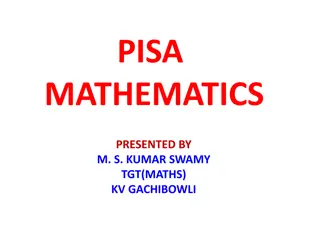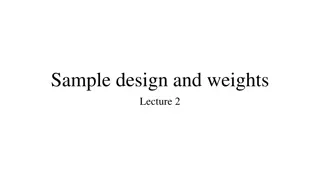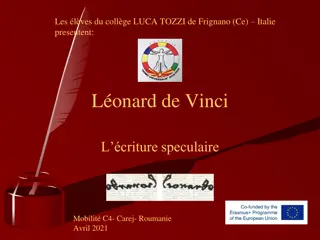
Exploring the Golden Ratio and Fibonacci Sequence
Dive into the intriguing world of the Fibonacci sequence and the Golden Ratio. Discover how the sequence unfolds, why the ratio settles to a fixed number, and how it relates to the captivating Golden Ratio. Unravel the mathematical beauty hidden within these sequences and explore their fascinating properties as they tend towards the Golden Ratio, a fundamental concept in mathematics and aesthetics.
Download Presentation

Please find below an Image/Link to download the presentation.
The content on the website is provided AS IS for your information and personal use only. It may not be sold, licensed, or shared on other websites without obtaining consent from the author. If you encounter any issues during the download, it is possible that the publisher has removed the file from their server.
You are allowed to download the files provided on this website for personal or commercial use, subject to the condition that they are used lawfully. All files are the property of their respective owners.
The content on the website is provided AS IS for your information and personal use only. It may not be sold, licensed, or shared on other websites without obtaining consent from the author.
E N D
Presentation Transcript
The ??term of a sequence is given by: ? ? 1 1+ 5 2 1 1 5 2 ??= 5 5 Work out the terms for the values of ? shown. ? ?? 4 6 10
? ?? ? ? ? ? ? ? ? ? ? ?? ?? ??
We should now have the following results: ? ?? ? ? ? ? ? ? ? ? ? ?? ?? ?? ? ? ? ? ? ?? ?? ?? ?? ??? Can you fill in the gaps? Have you seen this sequence before? It is the Fibonacci sequence
Work out the ratio ??+1 ?? ? ?? ? ? ? ? ? ? ? ? ? ?? ?? ?? ? ? ? ? ? ? ?? ?? ?? ?? ?? ??? ????? 1 2 1.5 1.6667 1.6 1.625 1.6154 1.619 1.61761.6182 1.618 It seems to settle to a fixed number. Do you know its name? Can you prove why the ratio settles to this number?
? ? 1 1+ 5 2 1 1 5 2 ??= 5 5 ?+1 ?+1 ?+1 ?+1 1 1+ 5 2 1 1 5 2 1+ 5 2 1 5 2 Ratio ??+1 5 5 = = ? ? ? ? ?? 1 1+ 5 2 1 1 5 2 1+ 5 2 1 5 2 5 5 ? As ? gets large what happens to the value of ? 1 5 2 1 5 2 Since value tends to zero. So, for large ? we can ignore that term. has magnitude less than 1, when raised to a large power its ?+1 1+ 5 2 So we are left with: Ratio ??+1 1+ 5 2 = ? = = ?.???? (5 ?.?) ?? 1+ 5 2 The Golden Ratio, ?
? ? 1 1+ 5 2 1 1 5 2 ??= 5 5 ?+1 ?+1 ?+1 ?+1 1 1+ 5 2 1 1 5 2 1+ 5 2 1 5 2 Ratio ??+1 5 5 = = ? ? ? ? ?? 1 1+ 5 2 1 1 5 2 1+ 5 2 1 5 2 5 5 ? As ? gets large what happens to the value of ? 1 5 2 1 5 2 Since value tends to zero. So, for large ? we can ignore that term. has magnitude less than 1, when raised to a large power its ?+1 1+ 5 2 So we are left with: Ratio ??+1 1+ 5 2 = ? = = ?.???? (5 ?.?) ?? 1+ 5 2 The Golden Ratio, ?
So the ratio ??+1 as ? gets large. ?? tends to the golden ratio This is true even if we start with any two numbers in stead of 1 and 1. Can you prove why this is the case?
5 9 14 23 37 60 97 157 254 411 665 1076 1741 2817 ratio 1.8 1.5556 1.6429 1.6087 1.6216 1.6167 1.6186 1.6178 1.6181 1.618 1.618 1.618 1.618 This sequence can be made from the addition of two multiples of the classic Fibonacci sequence. 5 5 4 9 10 4 14 15 8 23 25 12 37 40 20 60 65 32 97 105 52 157 170 84 254 275 136 411 445 220 665 1076 1741 2817 720 1165 1885 356 576 + = 932 5 Since the ratio of each one tends to the golden ratio so must the sum of them.
Work out the terms for the values of ? Work out the terms for the values of ? The nth term of a sequence is given by: The nth term of a sequence is given by: ? ? 1 5 1 5 2 2 5 5 ?? ?? 1 1 ? ? 10 9 4 6 3 6 ? ? 1+ 5 1+ 5 2 2 5 5 1 1 ??= ??= shown. shown. SIC_21 SIC_21
Work out the terms for the values of ? Work out the terms for the values of ? The nth term of a sequence is given by: The nth term of a sequence is given by: ? ? 1 5 1 5 2 2 5 5 ?? ?? 1 1 ? ? 7 3 5 8 3 4 ? ? 1+ 5 1+ 5 2 2 5 5 1 1 ??= ??= shown. shown. SIC_21 SIC_21
Work out the terms for the values of ? Work out the terms for the values of ? The nth term of a sequence is given by: The nth term of a sequence is given by: ? ? 1 5 1 5 2 2 5 5 ?? ?? 1 1 ? ? 12 4 5 9 4 8 ? ? 1+ 5 1+ 5 2 2 5 5 1 1 ??= ??= shown. shown. SIC_21 SIC_21
Work out the terms for the values of ? Work out the terms for the values of ? The nth term of a sequence is given by: The nth term of a sequence is given by: ? ? 1 5 1 5 2 2 5 5 ?? ?? 1 1 ? ? 9 4 5 8 4 8 ? ? 1+ 5 1+ 5 2 2 5 5 1 1 ??= ??= shown. shown. SIC_21 SIC_21
1 + 5 2 + 5 1 5 2 5 = = 1 + 5 2 + 5 1 5 2 5 = = 1 + 5 2 + 5 1 5 2 5 = = 1 + 5 2 + 5 1 5 2 5 = = 1 + 5 2 + 5 1 5 2 5 = =
2 10 5 1 + 5 2 3 + 5 2 1 + 5 2 123 + 55 5 2 1 5 2 11 5 5 2 = = = 6 3 11 1 5 2 1 + 5 2 1 + 5 2 199 + 89 5 2 = 9 4 5 = 2 + 5 = 12 4 7 1 + 5 2 1 + 5 2 7 + 3 5 2 1 5 2 29 13 5 2 = 161 72 5 = = 8 5 1 5 2 47 21 5 2 1 + 5 2 11 + 5 5 2 = = 6 9 1 + 5 2 1 5 2 = 9 + 4 5 = 38 17 5 2 7 10 1 5 2 3 5 2 1 + 5 2 29 + 13 5 2 1 5 2 123 55 5 2 = = = 3 8 11 1 5 2 1 + 5 2 47 + 21 5 2 1 5 2 199 89 5 2 = 2 5 = = 4 9 12 1 5 2 7 3 5 2 1 + 5 2 1 5 2 = = 38 + 17 5 = 161 72 5






















